Numerical Analysis and Parametric Optimization of T-Shaped Symmetrical Metasurface with Broad Bandwidth for Solar Absorber Application Based on Graphene Material
Abstract
:1. Introduction
2. Design and Modeling
2.1. Analysis of Absorption
2.2. Analysis of Graphene
3. Design and Results
Parametric Optimization
4. Conclusions
Author Contributions
Funding
Data Availability Statement
Conflicts of Interest
Abbreviations
| Abbreviations | Full Form |
| UV | Ultraviolet |
| SRR | Split ring resonator |
| CZTS | Copper zinc tin sulfide |
| MIM | Metal Insulator Metal |
| GST | Germanium-Antimony-Tellurium |
| ZnO | Zinc Oxide |
| Avg | Average |
References
- Li, L.; Lin, J.; Wu, N.; Xie, S.; Meng, C.; Zheng, Y.; Wang, X.; Zhao, Y. Review and Outlook on the International Renewable Energy Development. Energy Built Environ. 2022, 3, 139–157. [Google Scholar] [CrossRef]
- Elavarasan, R.M.; Shafiullah, G.M.; Padmanaban, S.; Kumar, N.M.; Annam, A.; Vetrichelvan, A.M.; Mihet-Popa, L.; Holm-Nielsen, J.B. A Comprehensive Review on Renewable Energy Development, Challenges, and Policies of Leading Indian States With an International Perspective. IEEE Access 2020, 8, 74432–74457. [Google Scholar] [CrossRef]
- Novas, N.; Garcia, R.; Camacho, J.; Alcayde, A. Advances in Solar Energy towards Efficient and Sustainable Energy. Sustainability 2021, 13, 6295. [Google Scholar] [CrossRef]
- Kler, A.M.; Zharkov, P.; Epishkin, N.O. Parametric optimization of supercritical power plants using gradient methods. Energy 2019, 189, 116230. [Google Scholar] [CrossRef]
- Surve, J.; Parmar, J.; Patel, S.K.; Jadeja, R. Comparative analysis of metasurface array-based solar absorber for visible region. Opt. Quantum Electron. 2021, 53, 696. [Google Scholar] [CrossRef]
- Cui, T.J.; Smith, D.R.; Liu, R. Metamaterials: Theory, Design, and Applications; Springer: New York, NY, USA, 2010; pp. 1–19. ISBN 9781441905727. [Google Scholar]
- Mahmud, S.; Karim, M.; Islam, S.S.; Shuvo, M.K.; Akter, T.; Almutairi, A.F.; Islam, M.T. A Multi-Band Near Perfect Polarization and Angular Insensitive Metamaterial Absorber With a Simple Octagonal Resonator for Visible Wavelength. IEEE Access 2021, 9, 117746–117760. [Google Scholar] [CrossRef]
- Mahmud, S.; Islam, S.S.; Mat, K.; Chowdhury, M.E.H.; Rmili, H.; Islam, M.T. Design and parametric analysis of a wide-angle polarization-insensitive metamaterial absorber with a star shape resonator for optical wavelength applications. Results Phys. 2020, 18, 103259. [Google Scholar] [CrossRef]
- Patel, S.K.; Parmar, J.; Katkar, V. Graphene-based multilayer metasurface solar absorber with parameter optimization and behavior prediction using Long Short-Term Memory model. Renew. Energy 2022, 191, 47–58. [Google Scholar] [CrossRef]
- Huang, H.-L.; Xia, H.; Guo, Z.-B.; Xie, D.; Li, H.-J. Design of Broadband Metamaterial Absorbers for Permittivity Sensitivity and Solar Cell Application. Chin. Phys. Lett. 2017, 34, 117801. [Google Scholar] [CrossRef]
- Abdelraouf, O.A.M.; Shaker, A.; Allam, N.K. Using all dielectric and plasmonic cross grating metasurface for enhancing efficiency of CZTS solar cells. Nanophotonics VII 2018, 10672, 246–255. [Google Scholar] [CrossRef]
- Hoque, A.; Islam, M.T.; Almutairi, A.F.; Faruque, M.R.I. Design of Split Hexagonal Patch Array Shaped Nano-metaabsorber with Ultra-wideband Absorption for Visible and UV Spectrum Application. Nanoscale Res. Lett. 2019, 14, 1–10. [Google Scholar] [CrossRef] [PubMed]
- Patel, S.K.; Parmar, J.; Katrodiya, D.; Nguyen, T.K.; Holdengreber, E.; Dhasarathan, V. Broadband metamaterial-based near-infrared absorber using an array of uniformly placed gold resonators. J. Opt. Soc. Am. B 2020, 37, 2163. [Google Scholar] [CrossRef]
- Parmar, J.; Patel, S.K.; Katrodiya, D.; Nguyen, T.K.; Skibina, J.S.; Dhasarathan, V. Numerical investigation of gold metasurface based broadband near-infrared and near-visible solar absorber. Phys. B Condens. Matter 2020, 591, 412248. [Google Scholar] [CrossRef]
- Nguyen, D.M.; Lee, D.; Rho, J. Control of light absorbance using plasmonic grating based perfect absorber at visible and near-infrared wavelengths. Sci. Rep. 2017, 7, 2611. [Google Scholar] [CrossRef]
- Li, Y.; Li, D.; Zhou, D.; Chi, C.; Yang, S.; Huang, B. Efficient, Scalable, and High-Temperature Selective Solar Absorbers Based on Hybrid-Strategy Plasmonic Metamaterials. Sol. RRL 2018, 2, 1800057. [Google Scholar] [CrossRef]
- Abdulkarim, Y.I.; Alkurt, F.; Awl, H.N.; Altıntaş, O.; Muhammadsharif, F.F.; Appasani, B.; Bakır, M.; Karaaslan, M.; Taouzari, M.; Dong, J. A Symmetrical Terahertz Triple-Band Metamaterial Absorber Using a Four-Capacitance Loaded Complementary Circular Split Ring Resonator and an Ultra-Thin ZnSe Substrate. Symmetry 2022, 14, 1477. [Google Scholar] [CrossRef]
- Dahlberg, O.; Valerio, G.; Quevedo-Teruel, O. Fully Metallic Flat Lens Based on Locally Twist-Symmetric Array of Complementary Split-Ring Resonators. Symmetry 2019, 11, 581. [Google Scholar] [CrossRef]
- Li, X.; Zheng, G.; Zhang, G.; Yang, J.; Hu, M.; Li, J.; Li, Y.; Lu, H.; Yin, Z. Highly Sensitive Terahertz Dielectric Sensor for Liquid Crystal. Symmetry 2022, 14, 1820. [Google Scholar] [CrossRef]
- Naveed, M.A.; Bilal, R.M.H.; Baqir, M.A.; Bashir, M.M.; Ali, M.M.; Rahim, A.A. Ultrawideband fractal metamaterial absorber made of nickel operating in the UV to IR spectrum. Opt. Express 2021, 29, 42911. [Google Scholar] [CrossRef]
- Li, C.; Pan, R.; Geng, G.; Zheng, R.; Gu, C.; Guo, H.; Li, J. Strong and Omnidirectional Light Absorption from Ultraviolet to Near-Infrared Using GST Metasurface. Laser Photon.-Rev. 2023, 17, 2200364. [Google Scholar] [CrossRef]
- Shafique, A.; Naveed, M.A.; Ijaz, S.; Zubair, M.; Mehmood, M.Q.; Massoud, Y. Highly efficient Vanadium Nitride based metasurface absorber/emitter for solar-thermophotovoltaic system. Mater. Today Commun. 2023, 34, 105416. [Google Scholar] [CrossRef]
- Kondaiah, P.; Niranjan, K.; John, S.; Barshilia, H.C. Tantalum carbide based spectrally selective coatings for solar thermal absorber applications. Sol. Energy Mater. Sol. Cells 2019, 198, 26–34. [Google Scholar] [CrossRef]
- Bilal, R.; Baqir, M.; Choudhury, P.; Naveed, M.; Ali, M.; Rahim, A. Ultrathin broadband metasurface-based absorber comprised of tungsten nanowires. Results Phys. 2020, 19, 103471. [Google Scholar] [CrossRef]
- Sun, K.; Riedel, C.A.; Wang, Y.; Urbani, A.; Simeoni, M.; Mengali, S.; Zalkovskij, M.; Bilenberg, B.; de Groot, C.H.; Muskens, O.L. Metasurface Optical Solar Reflectors Using AZO Transparent Conducting Oxides for Radiative Cooling of Spacecraft. ACS Photon. 2018, 5, 495–501. [Google Scholar] [CrossRef]
- Mehrabi, S.; Bilal, R.M.H.; Naveed, M.A.; Ali, M.M. Ultra-broadband nanostructured metamaterial absorber based on stacked square-layers of TiN/TiO2. Opt. Mater. Express 2022, 12, 2199. [Google Scholar] [CrossRef]
- Lin, K.-T.; Lin, H.; Yang, T.; Jia, B. Structured graphene metamaterial selective absorbers for high efficiency and omnidirectional solar thermal energy conversion. Nat. Commun. 2020, 11, 1389. [Google Scholar] [CrossRef]
- Geim, A.K.; Novoselov, K.S. The rise of graphene. Nat. Mater. 2007, 6, 183–191. [Google Scholar] [CrossRef]
- Patel, S.K.; Charola, S.; Parmar, J.; Ladumor, M.; Ngo, Q.M.; Dhasarathan, V. Broadband and efficient graphene solar absorber using periodical array of C-shaped metasurface. Opt. Quantum Electron. 2020, 52, 250. [Google Scholar] [CrossRef]
- Charola, S.; Patel, S.K.; Parmar, J.; Ladumor, M.; Dhasarathan, V. Broadband graphene-based metasurface solar absorber. Microw. Opt. Technol. Lett. 2020, 62, 1366–1373. [Google Scholar] [CrossRef]
- Olabi, A.; Abdelkareem, M.A.; Wilberforce, T.; Sayed, E.T. Application of graphene in energy storage device—A review. Renew. Sustain. Energy Rev. 2021, 135, 110026. [Google Scholar] [CrossRef]
- Patel, S.K.; Charola, S.; Jani, C.; Ladumor, M.; Parmar, J.; Guo, T. Graphene-based highly efficient and broadband solar absorber. Opt. Mater. 2019, 96, 109330. [Google Scholar] [CrossRef]
- Saurabh, Y.K.; Jha, P.A.; Dubey, P.K.; Jha, P.K.; Singh, P. Bandgap engineering in TiO2/rGO 1D photonic metasurfaces as broadband solar absorber. J. Appl. Phys. 2022, 131, 023106. [Google Scholar] [CrossRef]
- Parmar, J.; Patel, S.K.; Katkar, V. Graphene-based metasurface solar absorber design with absorption prediction using machine learning. Sci. Rep. 2022, 12, 2609. [Google Scholar] [CrossRef] [PubMed]
- Baqir, M.; Choudhury, P.; Akhtar, M.N. ZrN fractal-graphene-based metamaterial absorber in the visible and near-IR regimes. Optik 2021, 237, 166769. [Google Scholar] [CrossRef]
- Patel, S.K.; Surve, J.; Jadeja, R.; Katkar, V.; Parmar, J.; Ahmed, K. Ultra-Wideband, Polarization-Independent, Wide-Angle Multilayer Swastika-Shaped Metamaterial Solar Energy Absorber with Absorption Prediction using Machine Learning. Adv. Theory Simul. 2022, 5, 2100604. [Google Scholar] [CrossRef]
- Liao, M.; Gao, Y.; Xie, Y.; Zhu, J.; Li, Z.; Tian, W.; Zhu, Z. Investigation on the anti-aging properties enhancement mechanism of graphene on RA based on size effect. Case Stud. Constr. Mater. 2022, 17, e01634. [Google Scholar] [CrossRef]
- Guo, R.; Tang, J.; Gu, J.; Guo, G.; Feng, X. Analysis on the road performance of graphene composite rubber asphalt and its mixture. Case Stud. Constr. Mater. 2022, 17, e01664. [Google Scholar] [CrossRef]
- Ashraf, S.; Khan, S.; Oad, V.K. Microcracking monitoring and damage detection of graphene nanoplatelets-cement composites based on acoustic emission technology. Case Stud. Constr. Mater. 2023, 18, e01844. [Google Scholar] [CrossRef]
- Pereira, P.; Ferreira, D.P.; Araújo, J.C.; Ferreira, A.; Fangueiro, R. The Potential of Graphene Nanoplatelets in the Development of Smart and Multifunctional Ecocomposites. Polymers 2020, 12, 2189. [Google Scholar] [CrossRef]
- Kamedulski, P.; Lukaszewicz, J.; Witczak, L.; Szroeder, P.; Ziolkowski, P. The Importance of Structural Factors for the Electrochemical Performance of Graphene/Carbon Nanotube/Melamine Powders towards the Catalytic Activity of Oxygen Reduction Reaction. Materials 2021, 14, 2448. [Google Scholar] [CrossRef] [PubMed]
- González, Z.; Acevedo, B.; Predeanu, G.; Axinte, S.M.; Drăgoescu, M.-F.; Slăvescu, V.; Fernandez, J.J.; Granda, M.; Gryglewicz, G.; Melendi-Espina, S. Graphene materials from microwave-derived carbon precursors. Fuel Process. Technol. 2021, 217, 106803. [Google Scholar] [CrossRef]
- Selvam, P.P.; Narayanan, R. Random restart local search optimization technique for sustainable energy-generating induction machine. Comput. Electr. Eng. 2019, 73, 268–278. [Google Scholar] [CrossRef]
- Wang, Y.; Wang, P.; Zhang, J.; Cui, Z.; Cai, X.; Zhang, W.; Chen, J. A Novel Bat Algorithm with Multiple Strategies Coupling for Numerical Optimization. Mathematics 2019, 7, 135. [Google Scholar] [CrossRef]
- Li, J.; Lei, H.; Alavi, A.; Wang, G.-G. Elephant Herding Optimization: Variants, Hybrids, and Applications. Mathematics 2020, 8, 1415. [Google Scholar] [CrossRef]
- Eiben, A.; Smit, S. Parameter tuning for configuring and analyzing evolutionary algorithms. Swarm Evol. Comput. 2011, 1, 19–31. [Google Scholar] [CrossRef]
- Song, Y.; Wu, D.; Mohamed, A.W.; Zhou, X.; Zhang, B.; Deng, W. Enhanced Success History Adaptive DE for Parameter Optimization of Photovoltaic Models. Complexity 2021, 2021, 6660115. [Google Scholar] [CrossRef]
- Tyflopoulos, E.; Steinert, M. Topology and Parametric Optimization-Based Design Processes for Lightweight Structures. Appl. Sci. 2020, 10, 4496. [Google Scholar] [CrossRef]
- Patel, S.K.; Parmar, J.; Zakaria, R.B.; Sharafali, A.; Nguyen, T.K.; Dhasarathan, V. Sensitivity Analysis of Metasurface Array-Based Refractive Index Biosensors. IEEE Sensors J. 2021, 21, 1470–1477. [Google Scholar] [CrossRef]
- Patel, S.K.; Parmar, J.; Katkar, V. Metasurface-based solar absorber with absorption prediction using machine learning. Opt. Mater. 2022, 124, 112049. [Google Scholar] [CrossRef]
- Alsaif, H.; Patel, S.K.; Ben Ali, N.; Armghan, A.; Aliqab, K. Numerical Simulation and Structure Optimization of Multilayer Metamaterial Plus-Shaped Solar Absorber Design Based on Graphene and SiO2 Substrate for Renewable Energy Generation. Mathematics 2023, 11, 282. [Google Scholar] [CrossRef]
- Yu, P.; Chen, X.; Yi, Z.; Tang, Y.; Yang, H.; Zhou, Z.; Duan, T.; Cheng, S.; Zhang, J.; Yi, Y. A numerical research of wideband solar absorber based on refractory metal from visible to near infrared. Opt. Mater. 2019, 97, 109400. [Google Scholar] [CrossRef]
- Lin, H.; Sturmberg, B.C.P.; Lin, K.-T.; Yang, Y.; Zheng, X.; Chong, T.K.; de Sterke, C.M.; Jia, B. A 90-nm-thick graphene metamaterial for strong and extremely broadband absorption of unpolarized light. Nat. Photon. 2019, 13, 270–276. [Google Scholar] [CrossRef]
- Azad, A.K.; Kort-Kamp, W.J.M.; Sykora, M.; Weisse-Bernstein, N.R.; Luk, T.S.; Taylor, A.J.; Dalvit, D.A.R.; Chen, H.-T. Metasurface Broadband Solar Absorber. Sci. Rep. 2016, 6, 20347. [Google Scholar] [CrossRef]
- Liu, B.; Tang, C.; Chen, J.; Xie, N.; Tang, H.; Zhu, X.; Park, G.-S. Multiband and Broadband Absorption Enhancement of Monolayer Graphene at Optical Frequencies from Multiple Magnetic Dipole Resonances in Metamaterials. Nanoscale Res. Lett. 2018, 13, 153. [Google Scholar] [CrossRef]
- Sang, T.; Gao, J.; Yin, X.; Qi, H.; Wang, L.; Jiao, H. Angle-Insensitive Broadband Absorption Enhancement of Graphene Using a Multi-Grooved Metasurface. Nanoscale Res. Lett. 2019, 14, 105. [Google Scholar] [CrossRef]
- Rufangura, P.; Sabah, C. Graphene-based wideband metamaterial absorber for solar cells application. J. Nano Photon. 2017, 11, 036008. [Google Scholar] [CrossRef]
- Liu, Y.; Chen, Y.; Li, J.; Hung, T.-C.; Li, J. Study of energy absorption on solar cell using metamaterials. Sol. Energy 2012, 86, 1586–1599. [Google Scholar] [CrossRef]
- Patel, S.K.; Charola, S.; Parmar, J.; Ladumor, M. Broadband metasurface solar absorber in the visible and near-infrared region. Mater. Res. Express 2019, 6, 086213. [Google Scholar] [CrossRef]
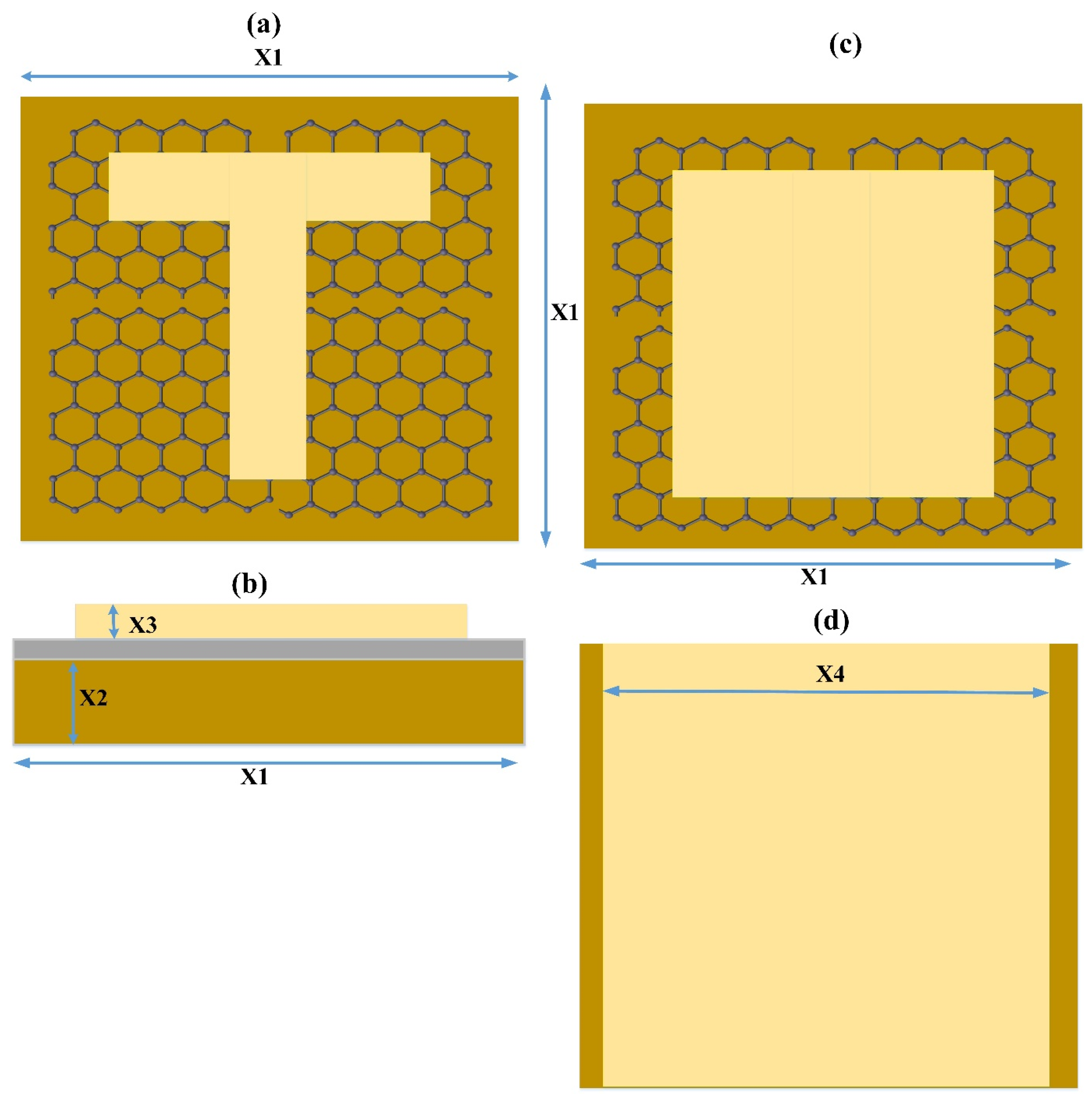
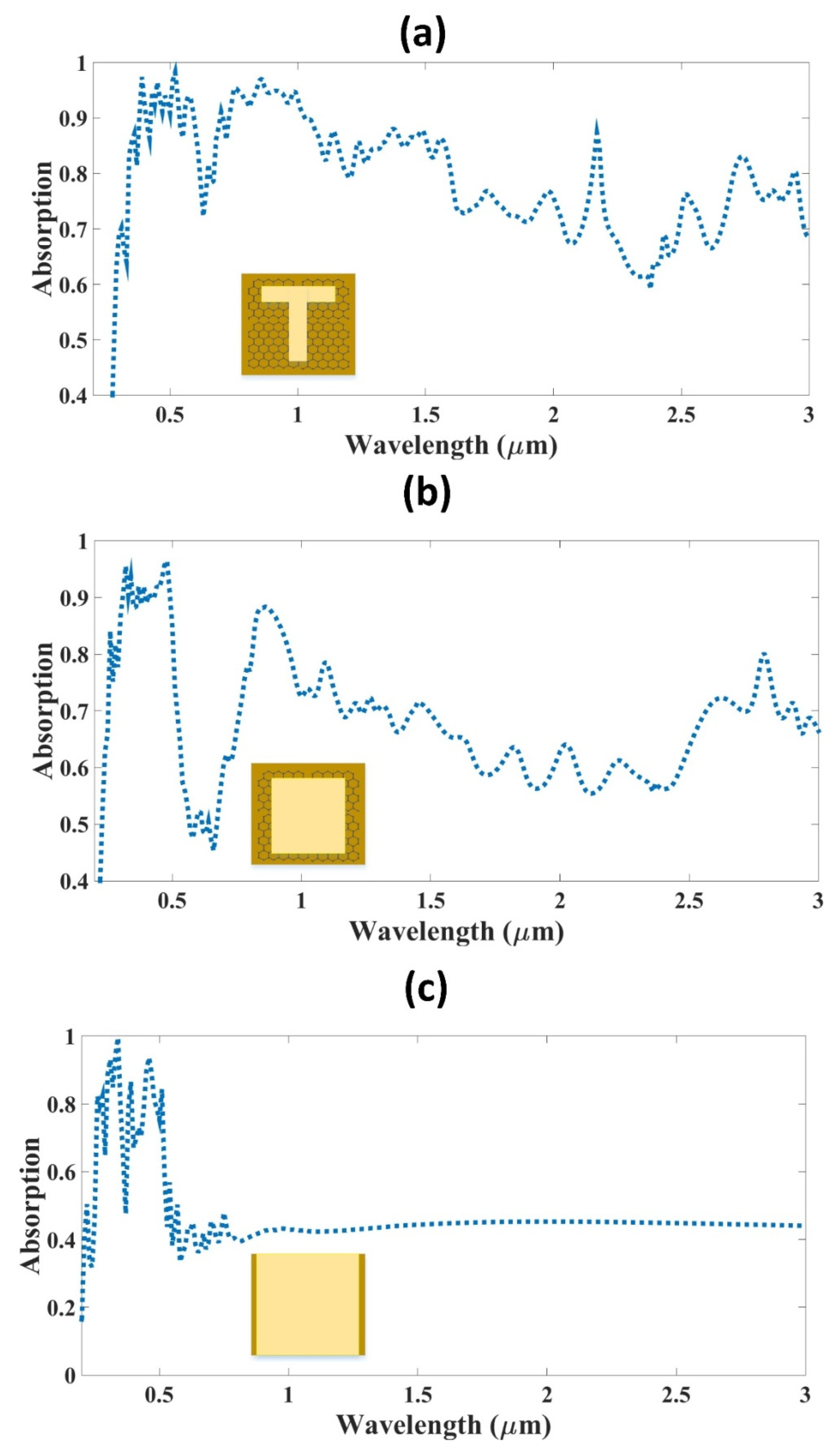
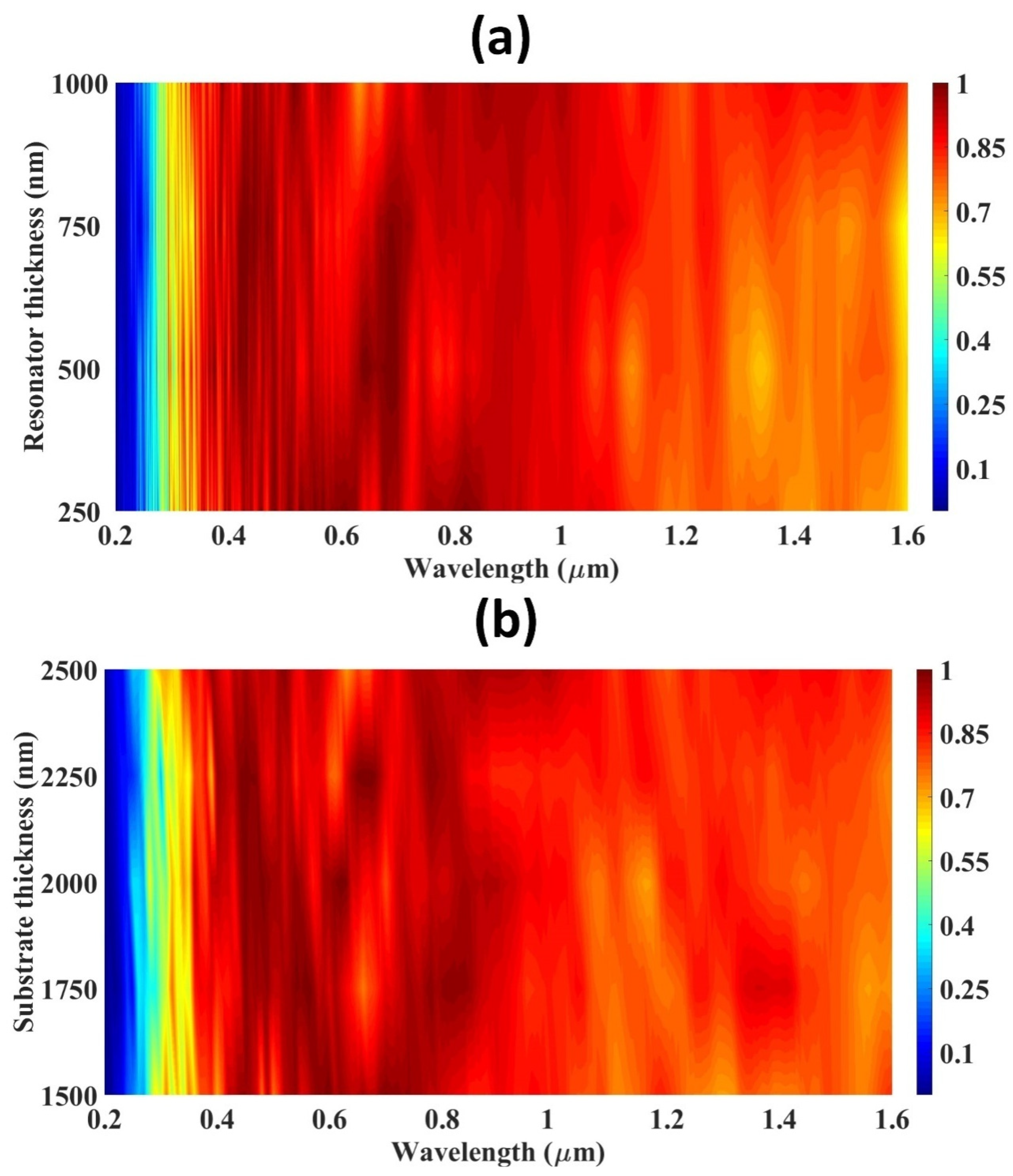


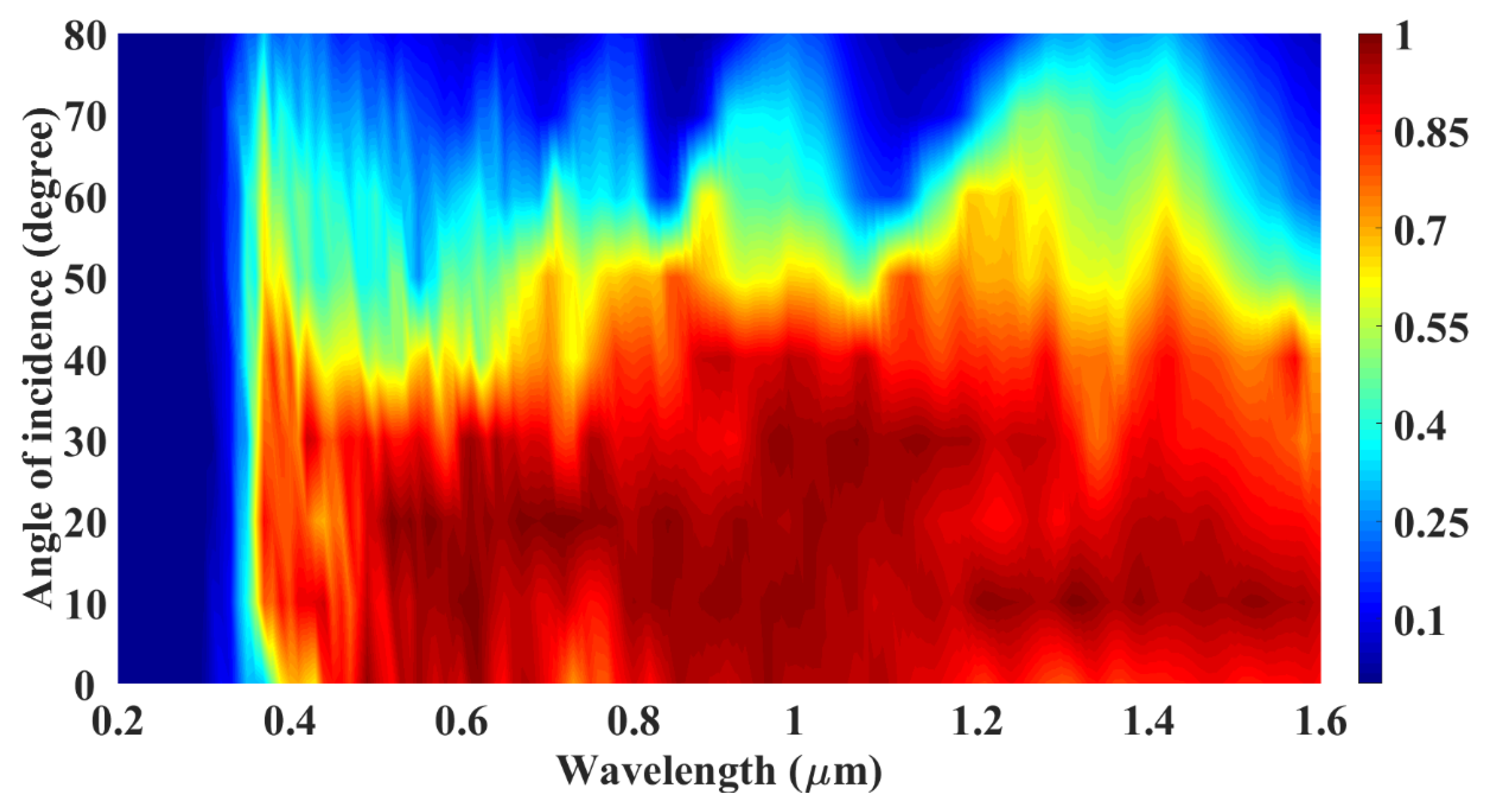
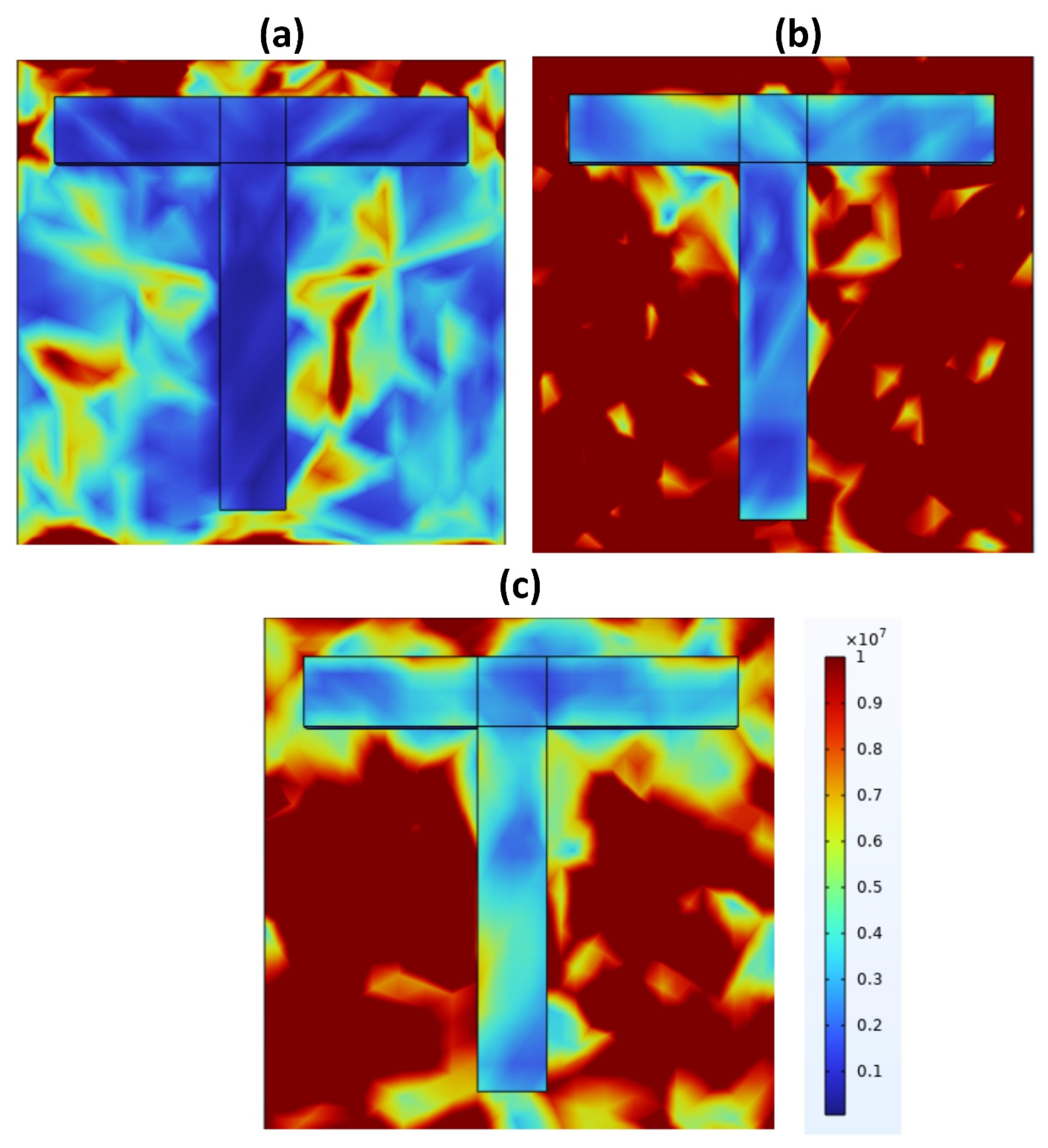
| 0.2 to 0.4 (Micrometer) (Avg. Absorption in %) | 0.4 to 0.7 (Micrometer) (Avg. Absorption in %) | 0.7 to 1.6 (Micrometer) (Avg. Absorption in %) | |
|---|---|---|---|
| T-shape metasurface design | 57 | 90 | 88 |
| Square-1 metasurface design | 60 | 71 | 72 |
| Square-2 metasurface design | 55 | 62 | 40 |
| Designs | 0.2 to 0.4 (Micrometer) (Avg. Absorption in %) | 0.4 to 0.7 (Micrometer) (Avg. Absorption in %) | 0.7 to 1.6 (Micrometer) (Avg. Absorption in %) |
|---|---|---|---|
| T-shape metasurface design | 57 | 90 | 88 |
| Square-1 metasurface design | 60 | 71 | 72 |
| Square-2 metasurface design | 55 | 62 | 40 |
| Refrectory Metal design [52] | - | 90 | - |
| Array of C-shaped metasurface design [29] | - | 86.5 | - |
| 90 nm thick graphene absorber design [53] | - | 93 | - |
| Broadband metasurface design [54] | - | 90 | - |
| Monolayer graphene design [55] | - | 80 | - |
| Multi grooved metasurface design [56] | - | 71.1 | - |
| Meta absorber for solar cell design [57] | - | 70 | - |
| Solar cell design [58] | - | 84 | 77 |
| Broadband absorber design [59] | - | 93.7 | - |
Disclaimer/Publisher’s Note: The statements, opinions and data contained in all publications are solely those of the individual author(s) and contributor(s) and not of MDPI and/or the editor(s). MDPI and/or the editor(s) disclaim responsibility for any injury to people or property resulting from any ideas, methods, instructions or products referred to in the content. |
© 2023 by the authors. Licensee MDPI, Basel, Switzerland. This article is an open access article distributed under the terms and conditions of the Creative Commons Attribution (CC BY) license (https://creativecommons.org/licenses/by/4.0/).
Share and Cite
Alsharari, M.; Armghan, A.; Aliqab, K. Numerical Analysis and Parametric Optimization of T-Shaped Symmetrical Metasurface with Broad Bandwidth for Solar Absorber Application Based on Graphene Material. Mathematics 2023, 11, 971. https://doi.org/10.3390/math11040971
Alsharari M, Armghan A, Aliqab K. Numerical Analysis and Parametric Optimization of T-Shaped Symmetrical Metasurface with Broad Bandwidth for Solar Absorber Application Based on Graphene Material. Mathematics. 2023; 11(4):971. https://doi.org/10.3390/math11040971
Chicago/Turabian StyleAlsharari, Meshari, Ammar Armghan, and Khaled Aliqab. 2023. "Numerical Analysis and Parametric Optimization of T-Shaped Symmetrical Metasurface with Broad Bandwidth for Solar Absorber Application Based on Graphene Material" Mathematics 11, no. 4: 971. https://doi.org/10.3390/math11040971
APA StyleAlsharari, M., Armghan, A., & Aliqab, K. (2023). Numerical Analysis and Parametric Optimization of T-Shaped Symmetrical Metasurface with Broad Bandwidth for Solar Absorber Application Based on Graphene Material. Mathematics, 11(4), 971. https://doi.org/10.3390/math11040971







